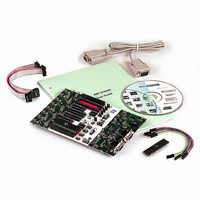ATSTK500 Atmel, ATSTK500 Datasheet - Page 24

ATSTK500
Manufacturer Part Number
ATSTK500
Description
PROGRAMMER AVR STARTER KIT
Manufacturer
Atmel
Series
AVR®r
Type
MCUr
Specifications of ATSTK500
Contents
Board, Cable, CD and Documentation
Data Bus Width
8 bit
Interface Type
RS-232
For Use With/related Products
Atmel AVR Devices
For Use With
ATADAPCAN01 - EXTENSION CAN ADD-ON TO STK500/1
Lead Free Status / RoHS Status
Lead free / RoHS Compliant
1925C–AVR–3/03
Hardware Description
3.7.2.2
3-14
Serial High-voltage
Programming
The 8-pin AVRs have too few pins to use parallel communication during High-voltage
Programming. They use serial communication instead.
This means that fewer signals have to be routed. Hardware setup for serial High-voltage
Programming is as follows:
1. Switch power off.
2. Place the device to program in its socket according to Table 3-3 on page 3-11.
3. Mount jumper OSCSEL on pins 1 and 2 to select software-controlled clock.
4. Mount jumper XTAL1 to route the oscillator signal to the device.
5. Mount jumpers VTARGET and RESET.
6. Use one 2-wire cable to connect the PB3 pin (pin 4) on the PORTB header to the
7. Use another 2-wire cable to connect the PB5 pin (pin 6) on the PORTB header to
8. Use a third 2-wire cable to connect the PB0 and PB2 pins (pins 4 and 3) on the
9. Use the last 2-wire cable to connect the PB1 pin (pin 1) on the SPROG1 header
10. Switch power on and you are ready to program.
All connections are shown in Figure 3-19.
Figure 3-19. Connection for Serial High-voltage Programming
XT1 pin (pin 7) on the PORTE/AUX header. This will connect the clock system to
the AVR device.
the RST pin (pin 4) on the PORTE/AUX header. This will connect the reset sys-
tem to the AVR device.
SPROG1 header to the DATA0 and DATA2 pins (pins 1 and 3) on the PROG
DATA header.
to the DATA1 pin (pin 2) on the PROG DATA header.
AVR STK500 User Guide












